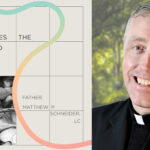Phyllis Zagano is well-known as one of the biggest advocates for female deacons in the Catholic Church. However, she has shown a lack of understanding the concept of Imago Dei (Image of God) in a way that really harms her argument. If she makes a mistake here, it undermines here argument for female deacons. This piece will note Church teaching on the Image of God, point out Zagano’s error, and note another issue she had with fundamental theology principles.
Church Teaching on the Image of God

The image and likeness of God is a fundamental principle when talking about how humans are all equal. I spend a lecture on this at the beginning of bioethics and mention it in fundamental moral theology. The point is that dignity is intrinsic, being based on being an individual member of the species homo sapiens, not extrinsic based on some ability or trait. Thus the unborn, the disabled, the sick and elderly, etc. all have equal human dignity to LeBron James, Elon Musk, or Pope Francis. Their lives are worth protecting.
This is based on Genesis 1:26-27: “Then God said, ‘Let us make man in our image, after our likeness; and let them have dominion over the fish of the sea, and over the birds of the air, and over the cattle, and over all the earth, and over every creeping thing that creeps upon the earth.’ So God created man in his own image, in the image of God he created him; male and female he created them.” It is clear that individual humans are made in the image and likeness of God. The latter part also notes both male and female are int he image of God and community or relationship is part of the image of God: marital relationship is prioritized, but this applies to all good relationships.
The Bible further indicates this image and likeness. Wisdom 2:23 indicates how it shows us eternal life: “God created man for incorruption & made him in the image of his own eternity.” 1 Corinthians 15:49 reminds us that Jesus elevates this image we all have: “Just as we have borne the image of the man of dust [Adam], we shall also bear the image of the man of heaven [Jesus].” From the rest of the letter, it is clear Paul is referring to both sexes in the Corinthian Church.
The Church has used this language in documents. For example, Dignitas Personae 16 quotes Benedict XVI stating: “God’s love does not differentiate between the newly conceived infant still in his or her mother’s womb and the child or young person, or the adult and the elderly person. God does not distinguish between them because he sees an impression of his own image and likeness (Gen 1:26) in each one.” This connects that image to the very start of human life and to our intrinsic dignity. Donum Vitae 5 repeats a similar idea: “From the moment of conception, the life of every human being is to be respected in an absolute way because man is the only creature on earth that God has ‘wished for himself’ and the spiritual soul of each man is ‘immediately created’ by God; his whole being bears the image of the Creator. Human life is sacred because from its beginning it involves ‘the creative action of God’ and it remains forever in a special relationship with the Creator, who is its sole end.”
Thus, the idea of image and likeness is clearly something Catholicism teaches is universal, inviolable, intrinsic, and from conception.
Zagano on Image of God
Recently, Zagano wrote about the Image of God in an RNS piece. It completely goes against fundamental principles of Catholic theology. She states: “He [Pope Francis] hinted at a non-ordained ‘diaconate’ of women in his televised interview, but that is a disaster waiting to happen in that it would require his stating that women cannot be ordained because they cannot image Christ — that they are not made in the image and likeness of God.”
I leave to the side here whether there will be “a non-ordained ‘diaconate’ of women,” as that is not the focus. The last two phrases are where the errors are: let’s go in reverse order.
She claims that denying female ordination would mean women were not made in the image and likeness of God. How? This is something intrinsic based on being an individual homo sapiens. Genesis is clear that both men and women were created in the image and likeness of God. This would go even further as it reduces image and likeness just to the ordained, or those with the capacity to be ordained. She not only falsely creates sexism not present in Catholic theology, but she also creates ableism as men with certain disabilities cannot be ordained.
Just before that, Zagano claims that only priests image Christ. This is simply false. As St. Paul noted (1 Corinthians 15:49, above), where we all share the image of Christ. Jesus is the Image of God par excellence, and we are all images in the Image. Even if we think of men, I as a priest am not in God’s image more than my dad or brother-in-law. In certain moments, the priest acts In Persona Christi, but that does not make us any more in Christ’s image. God’s image and Christ’s image are intrinsic.
Another Zagano Error
A little over a year ago, I wrote of a different Zagano error on basic Catholic theology. She completely misunderstands double effect. Here is a excerpt of what I wrote then:
She begins her piece:
Philosophers and moral theologians tell us that an objectively wrong action can be permitted if it intends to do good, citing the principle of “double effect.” Not everyone agrees, leading to various recent collisions of policy and action.
I am somewhat suspicious when people begin with philosophers and theologians without at least giving one example. Her point, though, is that objectively wrong action is morally OK if good is intended.
EDIT: later, they removed “objectively wrong” from the live version, which avoids the error. You can still see the original via Wayback Machine. You can see details about this change in an edit at the end of this piece.
This would reduce morality to intention only, as any object is permitted if good intentions are set. This is the exact opposite of what John Paul II said in Veritatis Splendor 78:
The morality of the human act depends primarily and fundamentally on the “object” rationally chosen by the deliberate will.
Following such moral principles would have disastrous consequences. One reply on Twitter pointed out: “the genocide by the Khmer Rouge intended to do good.” You could justify almost any evil this way, as most people or groups intend good.
You can read the rest there.
Based on these two errors that are quite elementary, Phyllis Zagano really harms her position promoting female deacons when she makes such fundamental errors of theology. The one about the Image of God is closer to her thesis but the other also adds evidence to indicate a degree of lacking understanding of Catholic theology. Theology, like many fields, needs a firm grasp of fundamentals to do higher level study well. As St. Thomas Aquinas starts De Ente et Essentia: “a little error in the beginning leads to a great one in the end.”
Zagano Harms Her Own Argument
I came into the issue of female deacons somewhat skeptical but open-minded. However, when the primary advocate shows such ignorance of basic theology, I am much more skeptical. When she does not understand the image of God or double effect, Zagano harms her argument for female deacons.






[…] Open the full article on the frmatthewlc.com site […]